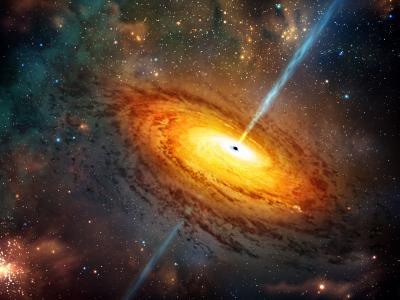An international team of astronomers has discovered two gigantic black holes with masses about 10 billion times the mass of our sun. These black holes have a mass more than 50 per cent greater than any other previously measured.
"They may be the dormant remains of quasars that were extremely luminous billions of years ago," says Professor James Graham, director of the Dunlap Institute for Astronomy and Astrophysics at the University of Toronto and founding member of the team behind the discovery.
A black hole is a region of space that has so much mass concentrated in it that there is no way for a nearby object to escape its gravitational pull. The masses of black holes are measured by figuring out how strong their gravity is. More mass means more gravity and a stronger effect on stars that orbit in the galaxies that they inhabit.
Using several telescopes − the Gemini Observatory, the MacDonald Observatory and the Keck Observatory – the scientists measured the speed of stars orbiting in these galaxies, thereby measuring the strength of the gravitational field of the black hole.
"Black holes inhabit the centres of nearly all galaxies − the centre of our very own Milky Way galaxy harbours a black hole four million times the mass of the sun − relatively speaking, a baby! But only a few dozens of these black holes have been 'weighed' carefully," says Graham.

This is an artist's impression of a supermassive black hole, with matter falling into it rotating as a disk heating up in its center, and two jets of relativistic particles emitted along the axis. Some gas and stars from the surrounding galaxy are visible in the background.
(Photo Credit: Casey Reed)
"We believe that 10-billion solar mass black holes like these are the ultimate power sources for the distant quasars observed in the early universe, one to three billion years after the Big Bang," he says. Quasars are among the brightest phenomena in the universe, emitted by material whirling around and falling into the black hole at the centre of a galaxy. The more massive the black hole, the more powerful the quasar can be.
More recently, quasars have toned it down: the ones closer to home are not nearly as luminous as those of 10 billion years ago. The light coming from the two galaxies the team observed shows them as they were less than half a billion years ago. No quasar there, but black holes massive enough to have powered extremely bright quasars several billions of years earlier.
"Our measurements of black holes with 10-billion solar masses in nearby galaxies show that these types of galaxies originally hosted very luminous quasars," says Graham. "For the last 10 billion years, these enormous black holes have been dormant."
To look for such massive black holes, the team turned their telescopes toward giant galaxies since there appears to be a tight correlation between properties of the host galaxy and the mass of its black hole. This key piece of evidence helps scientists piece together how galaxies and their central black holes form and grow. The correlation suggests there is a sort of feedback between the growth of the central black hole and the formation of the stars that eventually comprise the central region of the galaxy.
"But these newly measured black hole masses are a surprise," says Graham. "They are significantly more massive than predicted using the previously known correlations. Something that we had not anticipated for the most massive black holes must be at play here."
Source: University of Toronto